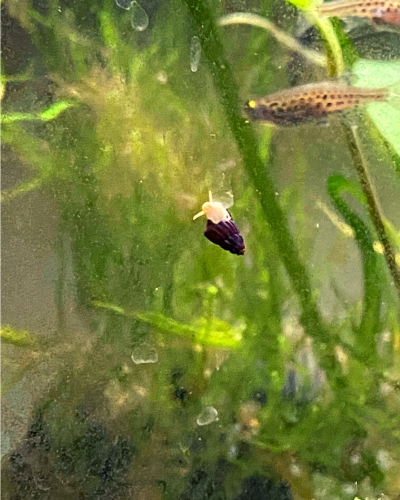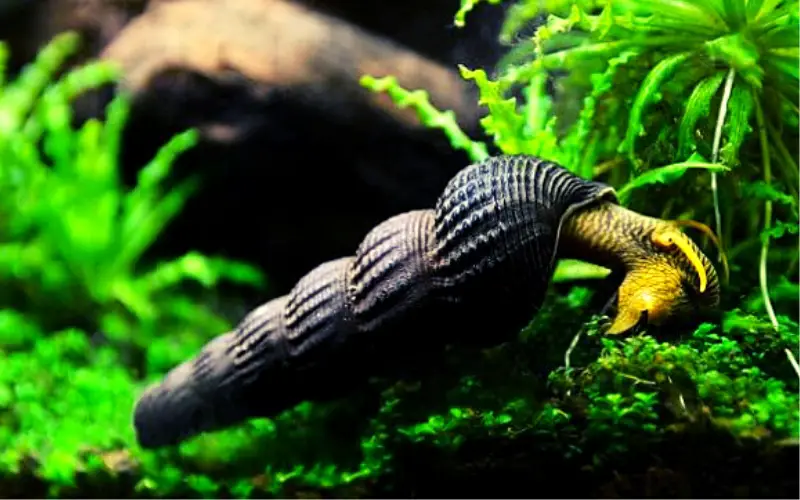The Baby Rabbit Snail, known as Tylomelania, is a popular choice for freshwater aquarium enthusiasts due to its unique appearance and behavior.
These small freshwater snails feature a rabbit-like face and are known for their peaceful nature and algae-eating abilities.
However, despite their aquarium hobby popularity, caring for Baby Rabbit Snails can be challenging, especially for beginner hobbyists.

To help you avoid potential disasters and ensure the health and well-being of your snails, we have compiled a list of expert tips.
From water parameters and tank mates to feeding habits and maintenance, these five key strategies will guide you in creating a suitable environment for your Rabbit Snail Baby to thrive.
Whether you are a seasoned aquarist or a novice snail keeper, these tips will help you provide the best care for your adorable aquatic companions.
Table of Contents
ToggleWhat Do Baby Rabbit Snails Look Like?
Baby rabbit snails, or kits, are incredibly small and delicate when they first hatch. They look like miniature versions of adult rabbit snails, but with a few key differences:
- Size: Kits are minuscule, often only a few millimeters in length.
- Shell: Their thin and translucent shells allow you to see their tiny bodies inside. As they grow, their shells will gradually harden and become more opaque.
- Color: Baby rabbit snails usually have the same color and pattern as their parents, though the colors may be less vibrant initially.
- Shape: They have the same distinctive elongated shape as adult rabbit snails, with a pointed apex and a wider body whorl.
It’s important to note that baby rabbit snails are very fragile. They require stable water conditions and a healthy environment to thrive. Ensure they have plenty of food and hiding places to ensure their survival.
What to Feed Baby Rabbit Snails?
When rabbit snail breeding, it is important to provide them with the right food to ensure their health and growth. In addition to the algae wafer from the pet store, you can also feed them plant-based foods such as java fern or spinach.

Other options include vegetables like zucchini or cucumber. Some pet owners even try adding small fish or betta food. The Malaysian trumpet snails and mystery snails may also enjoy a small piece of chocolate wafer as a treat.
For pregnant snails, it is important to prevent overfeeding to avoid complications during birth. Female snails typically give birth after about a month, and mama snails can have a new batch of 8-10 babies every few weeks. Feeding baby rabbit snails is easy, and learning more about these cute creatures can be fun.
What Are Common Care Issues For Rabbit Snails?
Rabbit snails are generally hardy and easy to care for, but there are a few essential things to keep in mind to ensure their health and happiness.
- Water Parameters: Rabbit snails prefer hard, alkaline water with a pH of 7.5 to 8.5 and a KH of 2 to 15. They are sensitive to copper, so avoid using tap water treated with copper. You can add cuttlebone to the tank to help maintain calcium levels.
- Diet: Rabbit snails are omnivores and will eat various foods, including algae, biofilm, detritus, blanched vegetables, and fish food. Providing them with multiple foods is important to ensure they get all the necessary nutrients.
- Tank Mates: Rabbit snails are peaceful community fish and can be kept with other fish, shrimp, and snails. However, avoid keeping them with aggressive fish Like Crayfish that may prey on them.
Here are some additional Baby rabbit snail care issues to watch out for:
- Shell Problems: If the water conditions are not right or the rabbit snail is not getting enough calcium, its shell may become soft and brittle.
- Predation: Some fish can eat rabbit snails like puffers and loaches.
- Overfeeding: Rabbit snails are voracious eaters and can overeat if they are not given enough food. This can lead to health problems, such as pollution of the tank.
5 Expert Tips to Keep Rabbit Snail Baby Thriving & Avoid Any Potential Disasters
Rabbit snails are fascinating additions to freshwater aquariums, and watching their young thrive is a rewarding experience. Here are five expert tips to ensure your baby rabbit snails flourish:
1. Provide a Nutritious & Varied Diet:
- Algae Abundance: Ensure healthy algae growth in the tank, as it’s the primary food source for baby rabbit snails. Supplement with algae wafers or blanched vegetables like zucchini and spinach.
- Calcium Boost: Offer calcium-rich foods like cuttlebone or crushed eggshells to support strong shell development.
- Variety is Key: Occasionally offer protein-rich treats like frozen bloodworms or daphnia to promote optimal growth.
2. Maintain Pristine Water Conditions:
- Regular Water Changes: Perform frequent water changes (25% weekly) to keep nitrate levels low and prevent ammonia buildup, which can be fatal to baby snails.
- Filtration & Aeration: Invest in a good filter and air pump to maintain oxygenation and water flow.
- Monitor Water Parameters: Regularly test the tank water for pH, ammonia, nitrites, and nitrates, ensuring they remain within the optimal range for rabbit snails.
3. Create a Safe & Comfortable Habitat:
- Plenty of Hiding Spots: Offer ample hiding places like caves, rocks, and plants where baby snails can feel secure and escape potential predators.
- Smooth Substrate: Opt for a soft, sandy substrate to prevent shell damage as baby snails graze and explore.
- Suitable Tank Mates: Choose peaceful tank mates that won’t harm or outcompete the snails for food. Avoid aggressive fish or invertebrates.
4. Separate Babies from Adults (Optional):
- Prevent Overcrowding: If your main tank is densely populated, consider separating baby snails into a separate nursery tank to ensure sufficient food and space for growth.
- Reduce Competition: This can also prevent adult snails from inadvertently harming the babies while competing for food or resources.
5. Patience is Key:
- Slow & Steady Growth: Remember, baby rabbit snails grow slowly. Be patient and provide consistent care; you’ll be rewarded with healthy, thriving snails!
- Observe & Adapt: Monitor your baby snails’ behavior and appearance regularly. Adjust your care routine as needed to address any issues or changing needs.
Bonus Tip: Research the specific needs of your rabbit snail species, as different types may have slightly varying requirements.
By following these expert tips and creating a nurturing environment, you’ll set your baby rabbit snails on the path to a healthy and fulfilling life in your aquarium.
What To Look For When Buying Rabbit Snails In Stores?
When buying rabbit snails in stores, several important factors must be considered. Firstly, look for a unique color variation, such as the pretty yellow rabbit snail or the orange elephant snail.
These colors can add interest to your community tank. Check for a white egg sack near the snail, as this indicates that it is likely a female ready to breed.
A breeder may have a picture of the snail’s spiral-shaped shell and information on its behavior and care. It’s important to ensure that the snails are captive-bred and free of disease or parasites.
Be cautious of purchasing snails in the store for too long, as they may adapt slowly to a new environment. Be curious and ask questions about the snail’s origins and care requirements to ensure it fits your tank correctly.
Some Different Types Of Rabbit Snails
Some different types of Rabbit Snails include the Black Spiral Rabbit Snail, white spotted rabbit snails, chocolate rabbit snails, and the Assassin Rabbit Snail. These organisms are known for their unique appearance and behavior, making them popular among captive aquarists.
The Black Rabbit Snail has a dark shell with striking spiral patterns, while the Assassin Snail gets its name from its predatory nature towards other snails, such as the Cory Snail.
According to some sources, around 10 Possible varieties of Snail Rabbit Snails may be available today, each with unique characteristics.
Commonly Asked Questions about Caring for Baby Rabbit Snails (FAQs)
How do you take care of a baby rabbit snail?
Elephant rabbit snails (Tylomelania) thrive in warm (76-84°F) hard, alkaline water with fine sand substrate. They eat algae and biofilm but supplement with calcium for strong shells. Avoid copper-based treatments!
How big are newborn rabbit snails?
Newborn rabbit snails are tiny! They hatch at about ¼ inch (6 millimeters) long. These little guys are almost invisible at first glance.
Do rabbit snails have live babies?
Yes, rabbit snails are livebearers! Unlike many snails, they give birth to live, fully-formed baby snails instead of laying eggs.
How long does it take for a baby rabbit snail to grow?
Rabbit snails grow slowly, reaching full size in about 1-2 years. They steadily add to their shell as they grow up to 3 inches long.
How many babies do rabbit snails have?
Rabbit snails typically lay one or two babies in a small white egg sack every 4-6 weeks. This makes their reproduction rate much slower than that of other aquarium snails.
What do baby rabbit snails eat?
Baby rabbit snails eat the same things as adults! They munch on algae, sinking pellets, and blanched veggies like zucchini. Just avoid overfeeding!
How often do rabbit snails have babies?
Rabbit snails reproduce at a slow pace compared to other snails. They lay eggs every 4-6 weeks, each containing 1-2 baby snails.
Conclusion
In conclusion, keeping a baby snail can be a delightful and rewarding experience. You might ensure their safety and well-being by following a few simple guidelines. Providing a suitable tank setup, maintaining water quality, offering a balanced diet, monitoring tank mates, and being cautious with handling are all essential steps to avoid potential disasters. Remember, these adorable creatures deserve our care and attention. So, if you’re considering bringing a baby rabbit snail into your home, prioritize their needs and create a safe tank environment for them to thrive. Happy snail-keeping!
Recommended Posts
- Keeping Rabbit Snail with Betta Fish Happy (5 Proven Tips)
- Rabbit Snail Lifespan: 5 Secrets to Double Their Years!
- How Do Rabbit Snails Reproduce: (Mind-Blowing Facts)
- Rabbit Snail Eggs 101: The Art of Snail Breeding in Tanks
- Rabbit Snail Breeding 101: A Comprehensive Beginner’s Guide
- Mini Rabbit Snail 101: Secrets for Raising Like a Pro!
- Freshwater Rabbit Snails Size 101: (Tank Size & Care Guide)
- Top 7 Exotic Types of Rabbit Snail (That Will Amaze You!)
- Do Rabbit Snail Burrow: 5 Reasons Why You NEED Them!




